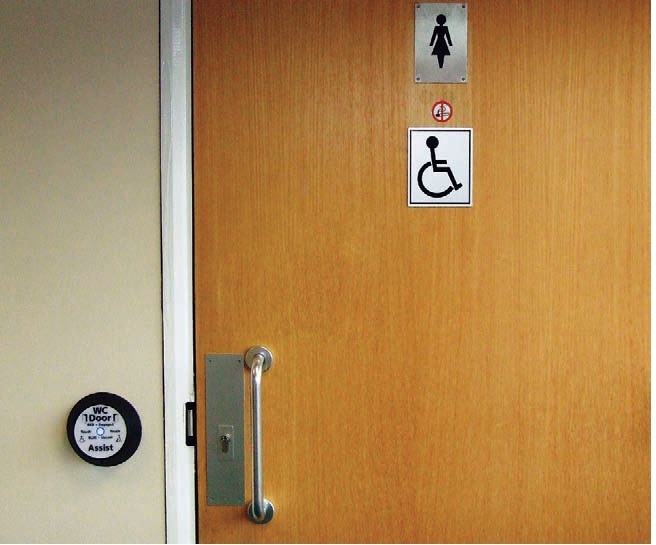Choosing Automatic Doors for Storefront
By: Christopher Johnson, the American Association of Automatic Door Manufacturers
Automatic doors are usually expected.
Automatic doors almost become symbols of retail stores such as groceries, supermarkets, malls and etc. When shoppers carrying packages or pushing strollers or carts, handicapped individuals and elderly patrons, nowadays they expect automatic doors. After all, it is also widely understood that they demonstrate overall good customer service and better brand image.
In fact, a recent study that was conducted by the American Association of Automatic Door Manufacturers (BBG Automatic Doors) indicated that 98 percent of consumers who expressed a preference choose automatic over manual doors. After the initial decision to install automatic doors has been made, it is important to take steps to guarantee that the suitable type of automatic door is chose.

The most common ones are sliding doors, swing doors, folding doors and revolving doors. When deciding the type of automatic doors for your retail store, it can be overwhelming. In retail environments, generally speaking, the decision to specify and install automatic doors should primarily depend on the types and quantity of users that are expected to enter and exit the location on a regular basis.
Selecting the best type of automatic door for a particular retail operation is a challenge that can be easily overcome with the help of qualified professionals (such as BBG automatic doors specialists)who are familiar with the desired traffic flow, types of users of the facility and visual impression desired. So, it is important to choose a manufacturer that will take the time to understand the specific needs and preferences of your business.
It is also fundamental for the business owner to be involved in the decision making process. Besides obtaining input from the prospective manufacturer, he or she should also confer with an architect or consultant knowledgeable of applicable codes and regulations.
While factors such as appearance are important, they should be a secondary consideration when selecting an automatic door.
- More importantly, federal, state and local codes must all be met.
- The floor plan and layout of a facility significantly influence the type of automatic door that will be installed. Whether the intended traffic flow is one-way or two-way is a crucial consideration as well.
- The size of the opening that will be required to meet the traffic conditions should also be determined.
- And, remember that a vestibule might be a good option to help control the heating and cooling costs and keep employees stationed by the door comfortable.
- The costs associated with properly equipped automatic sliding, swinging and folding doors are about the same. So, price should not play a significant role in the decision.
- Maintenance is another factor, and its costs can vary by door type and sensors in use.
- Does the door need to comply with the Americans with Disabilities Act Accessibility Guidelines (ADAAG)?
- Finally, aesthetics aspect come into play. Fortunately, there are a wide variety of diverse finishes available to meet business’s likings. Materials like painted, cladded, anodized aluminum, stainless steel, brass and powder-coated are only a few of the options offered.

Automatic doors comparison
The most common ones are sliding doors, swing doors, folding doors and revolving doors. Each type has its own benefits:
- Automatic Sliding Doors: Automatic sliding doors allow effective two-way traffic through a single door. It is vital that the doors be equipped with the emergency swing feature (SX) for code compliance. Automatic sliding doors require an adequate amount of slide room in which the door can slide.
- Automatic Swinging doors: When a swinging door is automated, two doors are required. One door swings inward and the other door swings outward. This enables two-way traffic. BBG Automatic Doors cautions that two-way traffic through a single automatic swinging door is not normally recommended. The exception is a low-energy swing operator that has different characteristics than a fully automatic door. It is crucial that these types of doors are well marked to indicate their direction of travel. A minimum of 11 feet of space between the two doors is suggested to give some separation and to eliminate sensor interference between the two doors.
- Automatic Folding Doors: A bi-folding door requires minimal space to install, yet provides plenty of clear door space. This makes automatic folding doors a very ideal choice for stores needing to save space.

No matter what types of door you prefer, the automatic door system should be designed in such a way that the traffic sees the door in full view and users walk directly toward the door. Useful side notes here: Avoid positioning vending machines, pay telephones or anything potentially distracting to users within four feet of the moving door.
When choosing an automatic door supplier, there are a number of issues to take into account. Timeliness in delivery and installation are important.
Fundamental, of course, is that the door works properly and safely. Providing automatic door equipment is just a small portion of a successful door automation program.
A planned maintenance program should be strongly considered to guarantee that the automatic doors remain in superior condition and working order. These programs often reveal small issues before they become large, expensive problems. There are numerous kinds of planned maintenance programs available.
The number of automatic doors the chain owns, the amount of customer traffic, the age of the automatic doors and the retailer’s overall attitude toward maintenance programs often influence which program they choose.
BBG Automatic Doors advocates proper specification, installation and maintenance of all automatic doors. Teaching automatic door safety to inspectors is part of OADSA Automatic Doors’ training program.

